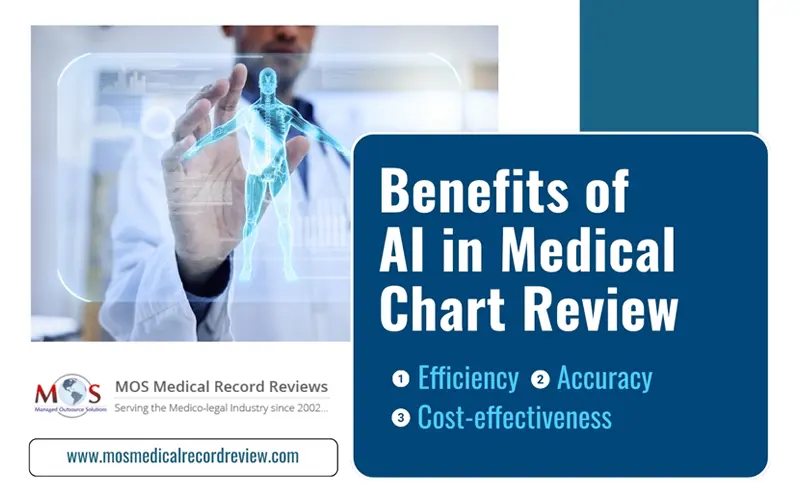As we step into 2025, the process of medical chart review is rapidly evolving, particularly in the legal sector. Law firms specializing in personal injury, medical malpractice, and workers’ compensation cases are increasingly faced with having to choose between AI-driven chart reviews and traditional manual reviews. What are the implications of this choice? We have come to a point where AI is becoming indispensable for successful business processes, and many business entities are considering using a hybrid model integrating AI and humans. AI vs. manual medical chart review –a clear understanding of this is crucial for efficient case management and optimal outcomes.
MOS Medical Record Reviews provides AI-powered and accurate review of medical records.
The Increasing Use of AI in Medical Chart Review
Artificial Intelligence (AI) has made significant strides in recent years, particularly in natural language processing and data analytics. The major benefits of AI in medical chart review include:
- Efficiency: AI algorithms can analyze vast amounts of data in a fraction of the time it takes human reviewers. This will help with quicker case resolutions.
- Accuracy: Advanced machine learning models can identify patterns and discrepancies that could be overlooked when the medical chart review is entirely manual, thereby enhancing the accuracy of medical record evaluations.
- Cost-effectiveness: By reducing the time lawyers and paralegals spend on document review, firms can cut costs and reallocate resources to other critical areas of their practice.
What Are the Challenges of AI Implementation?
Despite the many advantages, law firms need to consider the challenges involved when integrating AI into their workflow:
- Data Privacy: Compliance with HIPAA and other privacy regulations is paramount. You need to ensure that AI systems are designed to protect sensitive patient information.
- The Problem of Bias and Fairness: AI systems can accidentally perpetuate biases present in training data. Regular audits and adjustments are necessary to alleviate this risk.
- Training and Adaptation: Legal professionals may require training to effectively utilize AI tools, which can involve a learning curve and associated costs.
Manual Medical Record Review Is Still Significant
While AI tools come with impressive capabilities, manual chart review still holds significant value, particularly in complex cases that need nuanced understanding. Benefits include the following:
- Human Insight: Experienced reviewers can contextualize medical records, providing insights that AI may miss, especially in cases with unique medical histories.
- Legal Expertise: Understanding the legal implications of medical findings requires a depth of knowledge that human reviewers possess, ensuring that critical legal arguments are not overlooked.
A Hybrid Approach: The Best of Both Worlds
Many law firms are finding that hybrid approaches that combine AI medical record review with human expertise are most beneficial. This approach allows firms to leverage the speed and efficiency of AI while retaining the keen understanding and legal intelligence of manual reviewers. Key strategies to adopt include:
- Initial AI Screening: Use AI to perform preliminary reviews, flagging significant records or anomalies for further human examination.
- Continuous Feedback Loop: Implement a system where human reviewers provide feedback on AI findings, allowing the system to learn and improve over time.
Some Future Considerations for Law Firms
Law firms should remain proactive in evaluating their medical chart review processes. So, what are the key considerations?
- Investment in Technology: Staying updated with the latest AI advancements can provide a competitive edge.
- Training Programs: Developing training modules for staff on AI tools and data privacy regulations will be essential for seamless integration.
- Ethical Standards: Establishing clear ethical guidelines for the use of AI in legal practices will help maintain client trust and uphold the integrity of the legal profession.
It is not easy to make a choice between AI medical chart analysis and manual medical record review. Law firms must carefully consider the benefits and challenges of both approaches while considering a hybrid model as a possible solution. By staying informed and adaptable, firms can enhance their efficiency and effectiveness in handling their cases, ultimately leading to better client outcomes in 2025 and beyond.
To conclude, understanding the dynamics between AI and manual processes in medical record review is essential for law firms aiming to thrive in a competitive legal landscape. Also, it is important to adopt certain cost-saving strategies for law firms using AI technology. By embracing technological advancements while also valuing the importance of human insight in medical record analysis, firms can navigate the complexities of medical litigation effectively.





